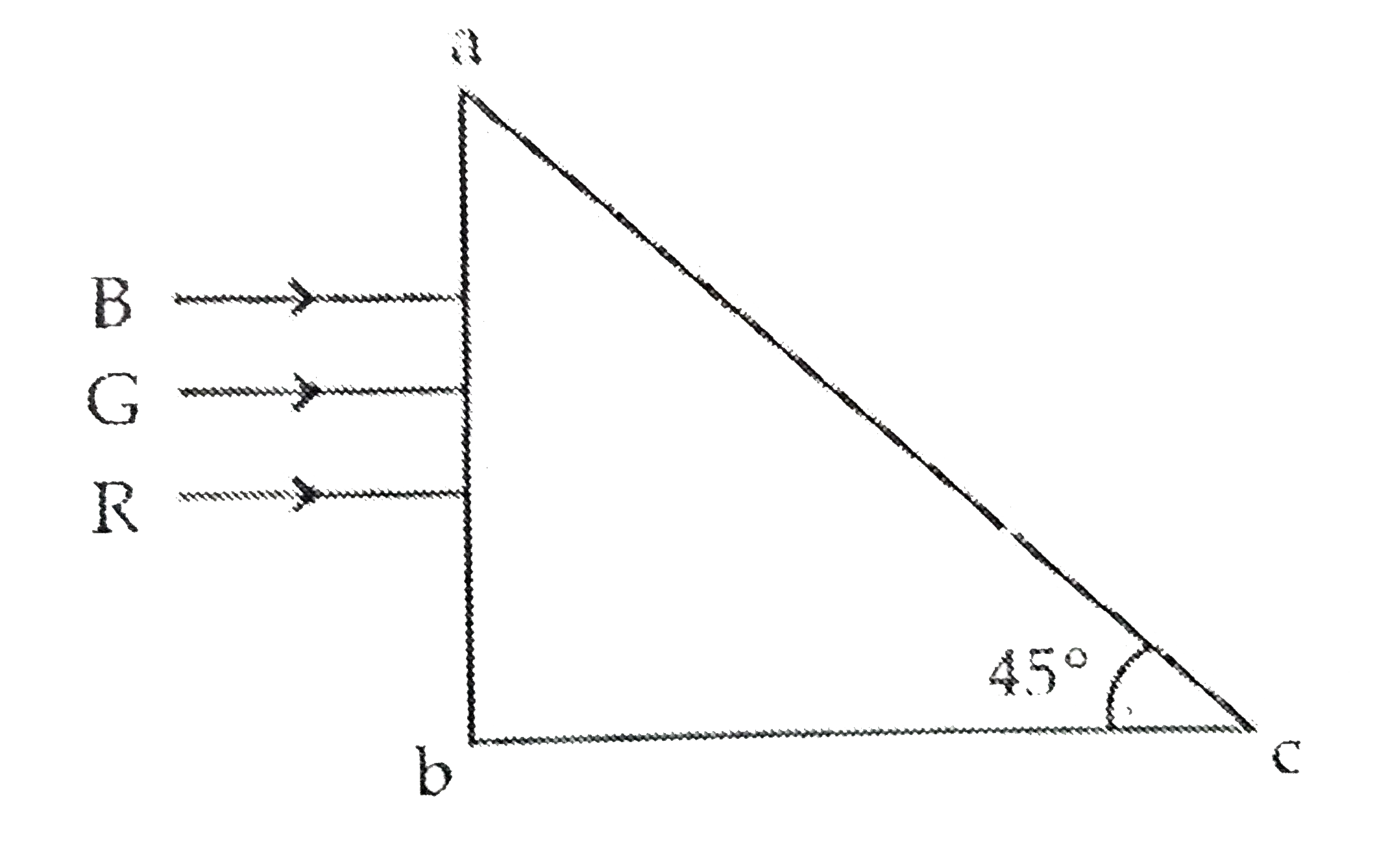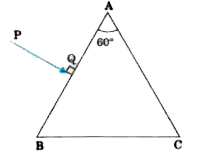Complete Solutions to Revision Exercises (Numerical Problems) of chapter RAY OPTICS AND OPTICAL INSTRUMENTS of Class 12 book with complete answers and questions
| Class 12 | PHYSICS |
| Chapter | RAY OPTICS AND OPTICAL INSTRUMENTS |
| MODERN PUBLICATION | Revision Exercises (Numerical Problems) |
| Number Of Questions | 36 |
| Academic Year | 2023-24 |
(a) An object of height 2.5 cm is placed perpendicularly on the principal axis of a concave mirror of focal length f at a distance of `(3)/(4)f`. What will be the nature of the image of the object and its height ?
(b) A person uses spectacles of power +2D. What type of defect of vision is it ?
View SolutionA 6 m tall tree is at a distance of 18 m from a pin hole camera. Where should a screen be placed to obtain a 20 cm tall image of the tree ?
View SolutionA candle is placed at 4 cm distance from a concave mirror. Radius of curvature of mirror is 10 cm. Find the position and magnification of the image.
View SolutionFind the areal magnification of a square object which is placed at a distance of 20 cm from a convex mirror of focal length 40 cm.
View SolutionAn object is placed in front of a concave mirror of radius of curvature `40 cm` at a distance of `10 cm`. Find the position, nature and magnification of the image.
View SolutionThe velocity of light in glass is `2 xx 10^(8) m//s` and in air is `3 xx 10^(8) m//s`. If the ray passes through glass to air, calculate the value of critical angle.
View SolutionThe refractive index of glass is 1.5 and that of water is 1.3. If the speed of light in water is `2.25 xx 10^(8) m///s`, what is the speed of light in glass ?
View SolutionVelocity of light in glass is `2 xx 10^(8) m//s` and that in air is `3 xx 10^(8) m//s`. Calculate the apparent shift of an ink dot covered by a 6 cm thick glass plate.
View SolutionA small bulb (assumed to be a point source) is placed at the bottom of a tank containing water to a depth of `80 cm`. Find out the area of the surface of water through which light from thr bulb can emerge. Take the value of refractive index of water to be `4//3`.
View SolutionA convex lens of focal length `20 cm` and a convex mirror of focal length `10 cm` are placed co-axially `50 cm` apart from each other. An incident beam parallel to its principal axis is incideent on the convex lens. Locate the position of final image formed due to the combination.
View SolutionA convex lens of focal length `25 cm` is placed co-axially in contact with a concave lens of focal length `20 cm`. Determine the power of the combination. Will the system be converging or diverging in nature ?
View SolutionA screen is placed 90 cm from an object. The image of the object on the screen is formed by a convex lens at two different positions separated by 20 cm. Calculate the focal length of the lens.
View SolutionA convex lens of focal length 20 cm and a concave lens of focal length 15 cm are kept 30 cm apart with their principal axes coincident. When an object is placed 30 cm in front of the convex lens, calculate the position of the final image formed by the combination. Would this result change if the object were placed 30 cm in front of the concave lens ? Give reason.
View SolutionA convex lens of focal length 0.24 m and of refractive index 1.5 is completely immersed in water of refractive index 1.33. Find the change in focal length of the lens.
View SolutionFind the radius of curvature of the convex surface of a plano-convex lens, whose focal length is 0.3 m and the refractive index of the material of the lens is 1.5.
View SolutionA lens forms real image of an object 20 cm away from lens. A second lens is kept in contact with this lens, then image shifts 10 cm towards the lens combination. Find the power of another lens.
View SolutionA beam of light converges to a point P. A lens is placed in the path of the convergent beam 12 cm from P. At what point does the beam converge if the lens is (a) a convex lens of focal length 20 cm. (b) a concave lens of focal length 16 cm.
View SolutionA concave lens is kept in contact with convex lens of focal length 20 cm. The combination works as a convex lens of focal length 50 cm. Find the power of concave lens.
View SolutionA convex lens of refractive index 1.5 has a focal length of 18 cm in air. Calculate the change in its focal length when it is immersed in water of refractive index `(4)/(3)`.
View SolutionA convex lens of power +5 D is placed in contact with a concave lens of power -4 D. What is the power of combination and nature of lens combination ?
View SolutionTwo identical equiconvex lenses of refractive index `3//2` and focal length 16 cm are kept in contact. The space between the lenses is filled with water of refractive index `4//3`. What is the focal length of the combination ?
View SolutionA prism of refractive index `1.53` is placed in water of refractive index `1.33`. If the angle of prism is `60^@`, calculate the angle of minimum deviation in water.
View SolutionA thin prism of `2^(@)` angle gives a deviation of `1^(@)`. What is the value of refractive index of the material of the prism.
View SolutionA ray of light passes through an equilateral prism in such a way that the angle of incidence is equal to the angle of emergence and each of these angles is `3//4`th the angle of the prism. Determine the (i) angle of deviation and (ii) the refractive index of the prism.
View SolutionThree light rays red (R), green (G) and blue (B) are incident on a right angled prism 'abc' at face 'ab'. The refractive indices of the material of the prism for red, green and blue wavelengths are 1.39 , 1.44 and 1.47 respectively. Out of the time three which colour ray will emerge out of face 'ac' ? Justify your answer. Trace the path of these rays after passing through face 'ab'

View SolutionFor a glass `(mu= sqrt(3) )` the angle of minimum deviation is equal to the angle of the prism. Find the angle of the prism.
View SolutionCalculate the speed of light in the prism if a ray of light is passing through an equilateral triangular glass prism from air and undergoes minimum deviation when angle of incidence is `5//4`th of the angle of prism.
View SolutionA ray PQ is incident normally on the face AB of a triangular prism of refracting angle of `60^(@)`, made of a transparent material of refractive index `2/sqrt(3)`, as shown in the figure. Trace the path of the ray as it passes through the prism. Also calculate the angle of emergence and angle of deviation.

View SolutionCalculate the angle of minimum deviation for an equilateral triangular prism of refractive index `sqrt(3)`.
View SolutionWhat will be the refractive index for yellow colour if the refractive index for red colour is 1.645 and for blue colour is 1.665 ? The spectrum is produced by a glass prism of dispersive power 0.052.
View SolutionCalculate the dispersive power of flint glass if deviations produced by violet, yellow and red lights are 4.42, 4.36, 4.32 respectively.
View SolutionThe far point of a person having myopia is 200 cm in front of the eye. Find the focal length and power of lens required to enable him see the distant objects clearly.
View SolutionThe near point of a person having hypermetropia is 60 cm in front of the eye. Find the focal length and power of lens required to enable him to see the objects clearly placed at 25 cm from the eye.
View SolutionBeing myopic, the far point for the left eye of a person has shifted to 1.5 metre while being hypermetropic, the near point for his right eye has shifted to 0.50 metre. Find the powers of the lenses used for the corrections.
View SolutionFor a normal relaxed eye, a simple microscope is rated as 3X. What will be the rating of a microscope for a relaxed farsighted eye whose near point is 50 cm.
View SolutionIf a convex lens of focal length 20 cm is held close to the eye of observer and the near point of the observer is 25 cm from the eye, find the distance of the object from the lens.
View Solution
Revision Exercises (Numerical Problems) questions and complete solutions for chapter RAY OPTICS AND OPTICAL INSTRUMENTS of MODERN PUBLISHERS PHYSICS (HINGLISH) of Class 12
All Exercises from MODERN PUBLICATION Class 12 PHYSICS RAY OPTICS AND OPTICAL INSTRUMENTS
- CHAPTER PRACTICE TEST
- Conceptual Questions
- Higher Order Thinking Skills & Advanced Level (QUESTIONS WITH ANSWERS)
- NCERT (EXemplar Problems Obejective Questions) (Multiple Choice Questions (Type-I)
- NCERT (EXemplar Problems Obejective Questions) (Multiple Choice Questions (Type-II)
- NCERT (Exemplar Problems Subjective Questions) (Very Short Answer Type Questions)
- NCERT FILE SOLVED (TEXT BOOK EXERCISES)
- OBJECTIVE TYPE QUESTIONS (A. MULTIPLE CHOICE QUESTIONS)
- OBJECTIVE TYPE QUESTIONS (ASSERTION REASON TYPE QUESTIONS)
- OBJECTIVE TYPE QUESTIONS (B. MULTIPLE CHOICE QUESTIONS)
- OBJECTIVE TYPE QUESTIONS (C. MULTIPLE CHOICE QUESTIONS)
- OBJECTIVE TYPE QUESTIONS (D. MULTIPLE CHOICE QUESTIONS)
- OBJECTIVE TYPE QUESTIONS (INTEGER TYPE QUESTIONS)
- OBJECTIVE TYPE QUESTIONS (JEE (ADVANCED) FOR IIT ENTRANCE)
- OBJECTIVE TYPE QUESTIONS (JEE (MAIN) & OTHER STATE BOARDS FOR ENGINEERING ENTRANCE)
- OBJECTIVE TYPE QUESTIONS (MATCHING TYPE QUESTIONS)
- OBJECTIVE TYPE QUESTIONS (MATRIX MATCH TYPE QUESTIONS)
- PRACTICE PROBLEMS (1)
- PRACTICE PROBLEMS (10)
- PRACTICE PROBLEMS (11)
- PRACTICE PROBLEMS (2)
- PRACTICE PROBLEMS (3)
- PRACTICE PROBLEMS (4)
- PRACTICE PROBLEMS (5)
- PRACTICE PROBLEMS (6)
- PRACTICE PROBLEMS (7)
- PRACTICE PROBLEMS (8)
- PRACTICE PROBLEMS (9)
- Revision Exercises (Additional Questions)
- Revision Exercises (Fill in the Blanks)
- Revision Exercises (Long Answer Questions)
- Revision Exercises (Numerical Problems)
- Revision Exercises (Short Answer Questions)
- Revision Exercises (Very Short Answer Questions)
- SOLVED EXAMPLES
- Tough & Tricky (PROBLEMS)